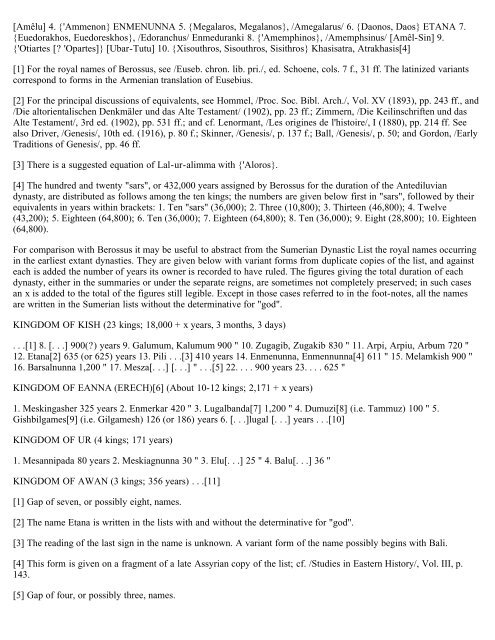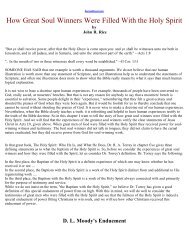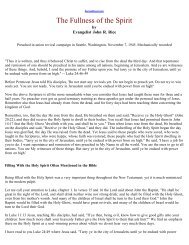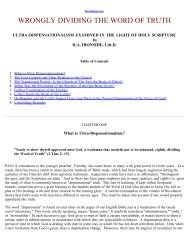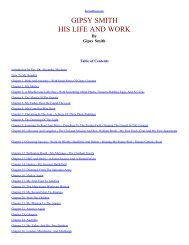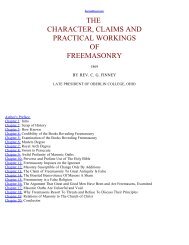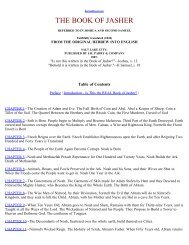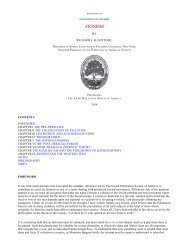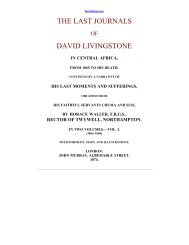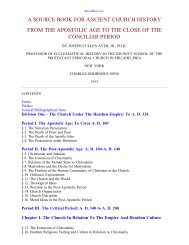Legends of Babylon and Egypt in Relation to Hebrew Tradition.pdf
Legends of Babylon and Egypt in Relation to Hebrew Tradition.pdf
Legends of Babylon and Egypt in Relation to Hebrew Tradition.pdf
You also want an ePaper? Increase the reach of your titles
YUMPU automatically turns print PDFs into web optimized ePapers that Google loves.
[Amêlu] 4. {'Ammenon} ENMENUNNA 5. {Megalaros, Megalanos}, /Amegalarus/ 6. {Daonos, Daos} ETANA 7.<br />
{Euedorakhos, Euedoreskhos}, /Edoranchus/ Enmeduranki 8. {'Amemph<strong>in</strong>os}, /Amemphs<strong>in</strong>us/ [Amêl-S<strong>in</strong>] 9.<br />
{'Otiartes [? 'Opartes]} [Ubar-Tutu] 10. {Xisouthros, Sisouthros, Sisithros} Khasisatra, Atrakhasis[4]<br />
[1] For the royal names <strong>of</strong> Berossus, see /Euseb. chron. lib. pri./, ed. Schoene, cols. 7 f., 31 ff. The lat<strong>in</strong>ized variants<br />
correspond <strong>to</strong> forms <strong>in</strong> the Armenian translation <strong>of</strong> Eusebius.<br />
[2] For the pr<strong>in</strong>cipal discussions <strong>of</strong> equivalents, see Hommel, /Proc. Soc. Bibl. Arch./, Vol. XV (1893), pp. 243 ff., <strong>and</strong><br />
/Die al<strong>to</strong>rientalischen Denkmäler und das Alte Testament/ (1902), pp. 23 ff.; Zimmern, /Die Keil<strong>in</strong>schriften und das<br />
Alte Testament/, 3rd ed. (1902), pp. 531 ff.; <strong>and</strong> cf. Lenormant, /Les orig<strong>in</strong>es de l'his<strong>to</strong>ire/, I (1880), pp. 214 ff. See<br />
also Driver, /Genesis/, 10th ed. (1916), p. 80 f.; Sk<strong>in</strong>ner, /Genesis/, p. 137 f.; Ball, /Genesis/, p. 50; <strong>and</strong> Gordon, /Early<br />
<strong>Tradition</strong>s <strong>of</strong> Genesis/, pp. 46 ff.<br />
[3] There is a suggested equation <strong>of</strong> Lal-ur-alimma with {'Aloros}.<br />
[4] The hundred <strong>and</strong> twenty "sars", or 432,000 years assigned by Berossus for the duration <strong>of</strong> the Antediluvian<br />
dynasty, are distributed as follows among the ten k<strong>in</strong>gs; the numbers are given below first <strong>in</strong> "sars", followed by their<br />
equivalents <strong>in</strong> years with<strong>in</strong> brackets: 1. Ten "sars" (36,000); 2. Three (10,800); 3. Thirteen (46,800); 4. Twelve<br />
(43,200); 5. Eighteen (64,800); 6. Ten (36,000); 7. Eighteen (64,800); 8. Ten (36,000); 9. Eight (28,800); 10. Eighteen<br />
(64,800).<br />
For comparison with Berossus it may be useful <strong>to</strong> abstract from the Sumerian Dynastic List the royal names occurr<strong>in</strong>g<br />
<strong>in</strong> the earliest extant dynasties. They are given below with variant forms from duplicate copies <strong>of</strong> the list, <strong>and</strong> aga<strong>in</strong>st<br />
each is added the number <strong>of</strong> years its owner is recorded <strong>to</strong> have ruled. The figures giv<strong>in</strong>g the <strong>to</strong>tal duration <strong>of</strong> each<br />
dynasty, either <strong>in</strong> the summaries or under the separate reigns, are sometimes not completely preserved; <strong>in</strong> such cases<br />
an x is added <strong>to</strong> the <strong>to</strong>tal <strong>of</strong> the figures still legible. Except <strong>in</strong> those cases referred <strong>to</strong> <strong>in</strong> the foot-notes, all the names<br />
are written <strong>in</strong> the Sumerian lists without the determ<strong>in</strong>ative for "god".<br />
KINGDOM OF KISH (23 k<strong>in</strong>gs; 18,000 + x years, 3 months, 3 days)<br />
. . .[1] 8. [. . .] 900(?) years 9. Galumum, Kalumum 900 " 10. Zugagib, Zugakib 830 " 11. Arpi, Arpiu, Arbum 720 "<br />
12. Etana[2] 635 (or 625) years 13. Pili . . .[3] 410 years 14. Enmenunna, Enmennunna[4] 611 " 15. Melamkish 900 "<br />
16. Barsalnunna 1,200 " 17. Mesza[. . .] [. . .] " . . .[5] 22. . . . 900 years 23. . . . 625 "<br />
KINGDOM OF EANNA (ERECH)[6] (About 10-12 k<strong>in</strong>gs; 2,171 + x years)<br />
1. Mesk<strong>in</strong>gasher 325 years 2. Enmerkar 420 " 3. Lugalb<strong>and</strong>a[7] 1,200 " 4. Dumuzi[8] (i.e. Tammuz) 100 " 5.<br />
Gishbilgames[9] (i.e. Gilgamesh) 126 (or 186) years 6. [. . .]lugal [. . .] years . . .[10]<br />
KINGDOM OF UR (4 k<strong>in</strong>gs; 171 years)<br />
1. Mesannipada 80 years 2. Meskiagnunna 30 " 3. Elu[. . .] 25 " 4. Balu[. . .] 36 "<br />
KINGDOM OF AWAN (3 k<strong>in</strong>gs; 356 years) . . .[11]<br />
[1] Gap <strong>of</strong> seven, or possibly eight, names.<br />
[2] The name Etana is written <strong>in</strong> the lists with <strong>and</strong> without the determ<strong>in</strong>ative for "god".<br />
[3] The read<strong>in</strong>g <strong>of</strong> the last sign <strong>in</strong> the name is unknown. A variant form <strong>of</strong> the name possibly beg<strong>in</strong>s with Bali.<br />
[4] This form is given on a fragment <strong>of</strong> a late Assyrian copy <strong>of</strong> the list; cf. /Studies <strong>in</strong> Eastern His<strong>to</strong>ry/, Vol. III, p.<br />
143.<br />
[5] Gap <strong>of</strong> four, or possibly three, names.


